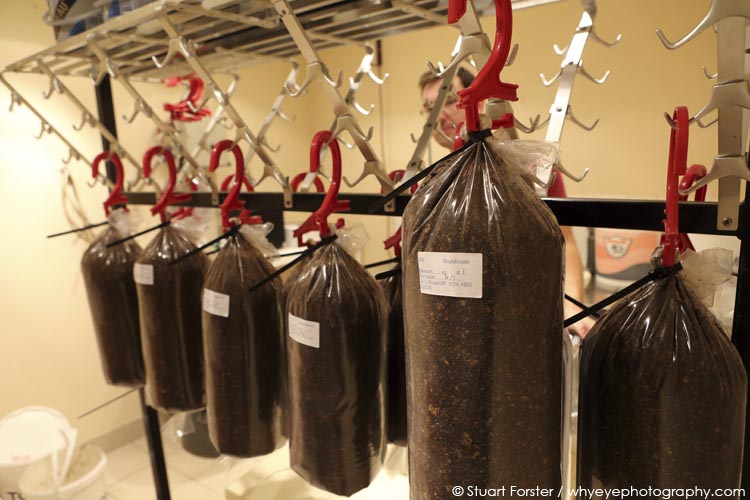Stuart Forster looks at how local entrepreneurs are harvesting mushrooms from old coffee in Rotterdam, the Netherlands.
A local man jokes that Tropicana in Rotterdam has changed from a zwemparadijs (swimming paradise) into a zwamparadijs (mushroom paradise). The former tropical leisure pool closed its doors to the public in 2010 and in 2013 became the centre of operations for Rotterzwam, a company producing oyster mushrooms.
Disclosure: Some of the links and banners below are affiliate links, meaning, at no additional cost to you, I will earn a commission if you click through and make a purchase.
“We were inspired by the book The Blue Economy by Gunter Pauli, a Belgian guy who tells people you can make new business models out of local stuff, waste especially, and this can make a difference and more jobs,” says Mark Slegers, who, along with Siemen Cox, is one of the two co-founders and directors of Rotterzwam. The idea they are following is one of the sustainable, environmentally friendly business models espoused by Pauli, who was born in Antwerp in 1956. Now living in Tokyo, Pauli founded the Zero Emissions Research and Initiatives think tank, ZERI, which, guided by Kyoto Protocol, aims to reduce carbon emissions.
Here’s a link to Gunter Pauli’s The Blue Economy on Amazon:

From coffee to oyster mushrooms
“If you drink coffee 99.8 per cent of the bean is thrown away. Only 0.2 per cent is in the cup. In the Netherlands, we are one of the biggest coffee drinkers in the world. About 120 million kilograms of coffee is imported every year,” says Slegers, giving background information about Rotterzwam’s source of energy for growing mushrooms.
“We collect coffee waste from cafes in central Rotterdam. We bring it here on a cargo bike and make a substrate out of it, mix it, and put oyster mushroom seeds in. Then it will become a mushroom in five to six weeks and we sell the mushrooms back to restaurants in the city,” explains the entrepreneur within the tiled basement of Tropicana.
Tropicana as a leisure hub
The site of Rotterzwam’s operations is a well-known riverside landmark. Tropicana was opened by Center Parcs in 1988, hosting a heated wave pool, waterslides, a sauna, beauty and wellness treatment areas plus a dance club. Unlike other properties owned by Center Parcs, Tropicana did not have accommodation and was sold in the early 1990s. People continued to use the pool and it slides until 2010, when the attraction was closed.
A base for local entrepreneurs
In 2013 the go-ahead was given for Tropicana to be used by local entrepreneurs. The terrace was re-opened as a café-bar, making use of loungers and seating left behind and recycled from the building’s previous incarnation. The concept has subsequently been developed further and Aloha now also incorporates a restaurant and a landscaped, sub-tropical park featuring indoor plants.
The premises are also the head office of Kromkommer, a company promoting the use of misshapen fruit and vegetables; products that are usually rejected by shops because they do not meet the exacting aesthetic expectations which modern society places on food products. Kromkommer found that produce such as double-legged and twisted carrots was being discarded as waste, despite being perfectly edible. The company produces soups and organises initiatives to distribute and sell misshapen farm produce.
The secret of the blend
In order to create the ideal base for growing mushrooms, Rotterzwam mixes waste from coffee beans, discarded during roasting, with the used grinds. “The mushrooms break down the chemicals in the coffee, so you don’t get the taste; they taste of normal oyster mushrooms,” says Slegers.
There’s also a practical reason why Rotterzwam keeps their operation local and collects grinds frequently. “If you have coffee grinds older than five days you have other fungus in it and you have to sterilise it, so that introduces energy costs,” says the company director.
Recycling waste for profit
Tropicana’s erstwhile changing rooms house the various phases of Rotterzwam’s operations, from the preparation of the substrate to mushrooms that are about to be harvested. Slegers shows off discarded clothes hangers, which he found on the site, from which plastic bags hang riddled with white fungal growth. Oyster mushrooms protrude from holes. Around 7,500kg are harvested annually.
Each bag is good for two or three mushroom harvests then becomes part of the 4,000 to 5,000 tonnes of compost produced by Rotterzwam each year. The company sells its compost back to the city, helping plants around the municipality to grow.
By-products for sale
This isn’t Rotterzwam’s only by-product. “Mushrooms break down the coffee grinds with enzymes. We extract them and sell these enzymes back to the water and sewerage companies who have waste. You can make biofuel from that waste. The yield of the biofuel will rise 20 per cent with enzymes, so they become more profitable,” says Slegers.
The entrepreneur believes that exchanging ideas in an open source manner is an effective means of spreading the popularity of the blue economy and changing how people think while benefitting the environment. “Nature makes no waste. If you look at nature and learn how it works you can make a profit,” he says.
Further information
Rotterzwam is based at Maasboulevard 100 in Rotterdam. Learn more about the city via the Rotterdam Info website.
For more about tourist attractions in the Netherlands see the Visit Holland website.
Photos illustrating this post are by Why Eye Photography.
If you enjoyed this post why not sign up for the free Go Eat Do newsletter? It’s a hassle-free way of getting links to posts on a monthly basis.
‘Like’ the Go Eat Do Facebook page to see more photos and content.




Kathryn Burrington
March 12, 2015 at 21:08What a great idea! Ticks so many boxes.
Stuart Forster
December 18, 2017 at 13:25Isn’t it! If I drank any more coffee than I already do I’d be growing them!